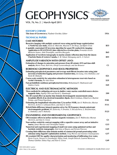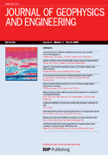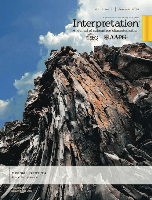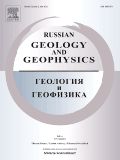
Geophysics
Scope & Guideline
Illuminating the Path to Energy Resources through Geophysics
Introduction
Aims and Scopes
- Seismic Imaging and Inversion Techniques:
Research focusing on advanced methods for seismic data acquisition, processing, and interpretation, including full-waveform inversion and least-squares migration, to enhance the understanding of subsurface structures. - Electromagnetic Methods:
Investigation of electromagnetic techniques for subsurface imaging and characterization, including controlled-source and ground-penetrating radar methods, emphasizing their application in mineral exploration and environmental monitoring. - Machine Learning and Data Science Applications:
Integration of machine learning and artificial intelligence techniques in geophysical data analysis, including noise reduction, feature extraction, and predictive modeling for improved accuracy in geophysical interpretations. - Geophysical Modeling and Simulation:
Development of numerical modeling approaches for simulating wave propagation in various media, encompassing both acoustic and elastic wave equations, to analyze the impact of geological features on wave behavior. - Near-surface Geophysics:
Focused studies on characterizing the near-surface environment to address practical challenges in engineering, environmental assessments, and archaeological investigations. - Geophysical Data Processing and Interpretation:
Research aimed at improving methodologies for processing geophysical data, including denoising techniques, inversion methods, and the integration of multi-modal data for enhanced subsurface characterization.
Trending and Emerging
- Deep Learning and AI in Geophysics:
There is a significant increase in publications utilizing deep learning and artificial intelligence for data analysis, interpretation, and inversion, indicating a transformative shift in how geophysical problems are approached. - Integrated Geophysical Techniques:
Research focusing on the integration of various geophysical methods (e.g., seismic, electromagnetic, and geoelectric) is gaining traction, reflecting a holistic approach to subsurface characterization. - Time-lapse Monitoring and Reservoir Management:
An emerging theme in geophysics involves time-lapse monitoring techniques for dynamic reservoir management, particularly in hydrocarbon and CO2 storage applications, highlighting the need for continual assessment of subsurface conditions. - Environmental Geophysics:
There is growing interest in applying geophysical methods to environmental studies, including groundwater monitoring, contamination assessment, and carbon capture, reflecting a broader societal focus on sustainability and environmental protection. - Near-surface Characterization Technologies:
Innovative techniques for near-surface characterization, particularly using distributed acoustic sensing and advanced ground-penetrating radar methodologies, are trending, addressing practical challenges in engineering and environmental contexts.
Declining or Waning
- Traditional Reflection Seismology:
There appears to be a waning focus on classical reflection seismology techniques in favor of more advanced and integrated methodologies, such as full-waveform inversion and machine learning approaches. - Single-method Geophysical Surveys:
The reliance on single-method surveys is decreasing as multi-method and integrated approaches become more favored, reflecting a trend towards comprehensive data acquisition and analysis strategies. - Static Data Analysis:
Research centered on static or less dynamic aspects of geophysical data is becoming less prevalent, with a shift towards time-lapse and dynamic monitoring techniques that provide insights into temporal changes in the subsurface. - Basic Rock Physics Models:
Interest in simplistic rock physics models is declining as researchers increasingly adopt more complex and accurate models that account for the heterogeneity and anisotropy of geological formations. - Field Case Studies:
While field case studies have historically been a staple of geophysical research, there is a noticeable decline in standalone case studies, with a trend towards incorporating broader datasets and comprehensive analyses.
Similar Journals

SURVEYS IN GEOPHYSICS
Unveiling the Secrets of Our Planet's Physical ProcessesSURVEYS IN GEOPHYSICS is a leading academic journal published by SPRINGER that has been at the forefront of advancing the field of geophysics and geochemistry since its inception in 1986. With an impressive impact factor and consistently ranked in the top quartile (Q1) of its categories—Geochemistry and Petrology, and Geophysics—this journal represents a vital resource for researchers and professionals alike. The journal is indexed in Scopus, where it ranks among the top ten in both Earth and Planetary Sciences sectors, reflecting its high citation rates and significant contributions to the field. Although not an open access journal, SURVEYS IN GEOPHYSICS provides invaluable insights into contemporary research trends and methodologies, fostering a deeper understanding of the physical processes that shape our planet. The journal welcomes original research articles, comprehensive reviews, and surveys that significantly contribute to our knowledge of geophysical phenomena and are dedicated to supporting the academic community through rigorous peer review and publication. Located in the Netherlands, SURVEYS IN GEOPHYSICS continues to establish itself as an essential platform for scholarly exchange and innovative ideas.

Journal of Geophysics and Engineering
Exploring the Intersection of Earth Sciences and Engineering InnovationJournal of Geophysics and Engineering, published by Oxford University Press, stands as a pivotal platform for the dissemination of innovative research in the interdisciplinary fields of geology, geophysics, and engineering. Since its inception in 2004, this Open Access journal has focused on advancing the understanding of geophysical phenomena and their applications in engineering, receiving a commendable Q2 ranking in multiple categories for 2023, including Geology and Geophysics. With an impressive Scopus ranking reflecting its influence—such as a 143rd position in Earth and Planetary Sciences: Geology—this journal is essential for researchers, professionals, and students seeking to engage with cutting-edge advancements and policy discussions in these critical areas. The journal’s commitment to fostering knowledge and collaboration within the global scientific community positions it as a must-read for those dedicated to furthering geophysical and engineering sciences.

Interpretation-A Journal of Subsurface Characterization
Elevating Understanding of Subsurface DynamicsInterpretation: A Journal of Subsurface Characterization is a premier academic journal dedicated to advancing the methodologies and technologies integral to the characterization of subsurface environments. Published by the Société de l'Exploration Geophysicists (SEG), this journal serves the fields of geology and geophysics, reflecting its critical role in the intersection of these domains. With an h-index that underscores its scholarly impact and its ranking in the Q2 category for both Geology and Geophysics, Interpretation is recognized for publishing high-quality, innovative research that offers valuable insights and solutions to contemporary challenges in subsurface exploration. Since its inception in 2013, the journal has quickly become essential reading for researchers, professionals, and students alike, providing open access to a wealth of knowledge fostering collaboration and advancement within the geoscience community. Featuring a comprehensive range of studies, methodologies, and reviews, Interpretation is integral for professionals striving to enhance their understanding of subsurface dynamics and impacting areas such as resource management, environmental conservation, and hazard assessment.

Bulletin of Geophysics and Oceanography
Bridging Disciplines for a Sustainable EarthBulletin of Geophysics and Oceanography is a distinguished open-access journal published by the IST NAZIONALE DI OCEANOGRAFIA E DI GEOFISICA in Italy, dedicated to advancing knowledge in the multidisciplinary fields of geophysics, oceanography, and related engineering disciplines. Since its inception in 2000, the journal has been pivotal in providing a platform for innovative research and comprehensive reviews that support the scientific community's efforts to understand Earth's dynamic systems. With an ISSN of 2785-339X and an E-ISSN of 2785-2970, the journal operates under an open-access model, ensuring that groundbreaking discoveries reach a wider audience without barriers. The Bulletin is categorized in the Q4 quartile for the years 2023 in Computers in Earth Sciences, Geophysics, Geotechnical Engineering and Engineering Geology, and Oceanography. It ranks within the 41st and 37th percentiles in geophysics and oceanography respectively, highlighting its emerging influence in the scientific community. The journal welcomes submissions that span across fundamental research and applied sciences, aiming to foster collaboration among researchers, professionals, and students, thereby contributing to the sustainable management of oceanic and terrestrial resources.

Geology Geophysics and Environment
Exploring Earth’s Mysteries, One Article at a Time.Geology Geophysics and Environment, published by AGH University of Science & Technology Press, is a prominent, open-access journal that has been disseminating knowledge since its inception in 2012. With its ISSN 2299-8004 and E-ISSN 2353-0790, this scholarly journal serves as a vital platform for researchers, professionals, and students interested in the interdisciplinary fields of geology, geophysics, and environmental science. By providing unrestricted access to a wide array of high-quality research articles, Geology Geophysics and Environment facilitates the sharing of innovative ideas and advancements that address some of the most pressing challenges in earth sciences today. Recognized for its contributions to the field, this journal is crucial for anyone looking to stay abreast of the latest trends and discoveries in the dynamic landscapes of geology and environmental research.

Solid Earth Sciences
Advancing our understanding of Earth's hidden depths.Solid Earth Sciences is a dynamic open-access journal published by Elsevier, dedicated to advancing our understanding of the Earth's subsurface processes and materials. Since its inception in 2016, the journal has established itself as a vital resource for researchers and professionals in the fields of geochemistry, petrology, geology, geophysics, and geotechnical engineering, achieving a notable Q2 ranking in multiple categories as of 2023. With an ISSN of 2451-912X, the journal aims to disseminate high-quality research that enhances knowledge of earth surface processes and the intricate interactions within our planet's systems. The journal is indexed in Scopus, showcasing an impressive rank in various sub-disciplines, with a rank of #96 in Geology and a noteworthy percentile in Earth and Planetary Sciences. Solid Earth Sciences offers a platform for innovative studies, comprehensive methodologies, and cutting-edge technological advancements that cater to a global audience of scientists, academics, and students. With its commitment to open access, it fosters wider dissemination and impact of research outcomes, ensuring that pivotal discoveries reach stakeholders and contribute to real-world applications.

Acta Geophysica
Innovating Insights into Earth's Dynamic Processes.Acta Geophysica is a distinguished peer-reviewed journal published by Springer International Publishing AG, focusing on the dynamic field of Geophysics. With an ISSN of 1895-6572 and an E-ISSN of 1895-7455, this journal stands as a critical platform for disseminating cutting-edge research and advancements from 2006 to 2024. Acta Geophysica maintains a respectable impact factor, reflecting its contribution to the global scientific community, where it ranks in the Q2 category within Geophysics, and is positioned 55 out of 165 in Scopus' Earth and Planetary Sciences, placing it in the 66th percentile. Based in Switzerland, the journal invites submissions that address a diverse range of topics, including seismic studies, geodynamics, and climate change impacts, thereby fostering in-depth discussions and innovative solutions in geophysical research. Access to the journal's content is offered through subscription-based options, ensuring a sustainable model for high-quality scientific exchange. By connecting researchers, professionals, and students, Acta Geophysica plays a vital role in advancing the understanding of Earth's processes and contributing to the field's evolution.

Applied Geophysics
Integrating Research and Practice in Geophysical StudiesApplied Geophysics is a premier journal dedicated to the interdisciplinary study of geophysical processes and their applications across various domains, published by SPRINGER. With an ISSN of 1672-7975 and an E-ISSN of 1993-0658, this journal serves as a pivotal platform for researchers, professionals, and students to share their latest findings and insights in the field of geophysics. Operating from China, the journal has established itself within the Q3 quartile in Geophysics as of 2023, reflecting its commitment to high-quality research, even as it ranks #105 out of 165 in the Earth and Planetary Sciences category, placing it in the 36th percentile on Scopus rankings. This makes it an essential resource for advancing knowledge in geophysical methodologies and applications. While it operates in a traditional subscription model, its relevance and timeliness ensure it remains a crucial outlet for emerging scientific discussions. The journal particularly encourages the integration of practical applications with theoretical frameworks, fostering innovation in areas such as environmental geophysics, resource exploration, and hazard assessment.

PURE AND APPLIED GEOPHYSICS
Exploring the Depths of Geophysical KnowledgePure and Applied Geophysics, published by Springer Basel AG, is a leading international journal in the fields of Geochemistry and Petrology as well as Geophysics, recognized for its significant contributions to advancing our understanding of the Earth's processes. With an impact factor that positions it in the Q2 category of both specialties, this journal is highly regarded within the scientific community, holding a commendable Scopus ranking of 49 out of 165 in Geophysics and 58 out of 154 in Geochemistry and Petrology. Established in 1964 and continuing to offer valuable research until 2024, it plays a crucial role in disseminating high-quality research findings and methodologies. Scholars and professionals can look forward to a diverse range of articles that cover fundamental and applied aspects, encouraging cross-disciplinary dialogue. Although it does not currently offer open access options, readers can access its wealth of knowledge through institutional subscriptions, making it an essential resource for those engaged in Earth sciences research.

Russian Geology and Geophysics
Advancing Earth Sciences through Rigorous ResearchRussian Geology and Geophysics is a seminal journal published by GEOSCIENCEWORLD that plays a pivotal role in the dissemination of vital research within the realms of Earth-Surface Processes, Geology, and Geophysics. With an ISSN of 1068-7971 and an E-ISSN of 1878-030X, this journal has witnessed a continuous evolution since its convergence in 2007 and is poised to thrive through 2024. While it is not an Open Access journal, it is recognized for its significant contributions to the academic community, holding a respectable Q2 ranking in Earth-Surface Processes and Q3 rankings in both Geology and Geophysics as of 2023. The journal’s impact factors align it within competitive quartiles, marking it as an essential resource for researchers and professionals seeking to stay at the forefront of geological and geophysical sciences. By publishing high-quality peer-reviewed articles, the journal fosters an environment of knowledge sharing and innovation, making it indispensable for students, practitioners, and scholars alike who are dedicated to advancing our understanding of Earth's complex systems.